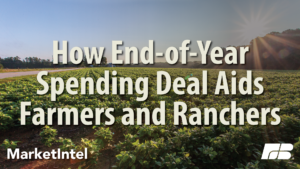AFBF Offers Testimony on Cheese and Butter Pricing at FMMO Hearing
AFBF Staff

photo credit: AFBF Photo
American Farm Bureau Federation Chief Economist Roger Cryan presented the testimony below on behalf of AFBF and its membership at the ongoing Federal Milk Marketing Order Pricing Formula hearing. This is the second time Cryan has testified before the hearing, and he is expected to testify several additional times.
The American Farm Bureau Federation (AFBF) has nearly 6 million members in all 50 states and Puerto Rico, including many thousands of cooperative and independent dairy farmers. All of these dairy farmers are indirectly or (mostly) directly affected by the pricing provisions of the Federal Milk Marketing Orders (FMMOs).
These dairy farmers play a crucial role in the development of AFBF dairy policy. Every Farm Bureau position and proposal is based explicitly on that policy, developed through a grassroots process in which farmers make the decisions at every step of the way.
AFBF submitted 9 proposals for consideration in this hearing, and appreciates the opportunity to address the four that were accepted by USDA for consideration in this hearing, as well as the clear direction on what may be needed to advance the rest.
A fundamental focus of AFBF’s proposals is the reduction or elimination of negative producer price differentials and the de-pooling they cause. We believe that an orderly pool is the key to orderly marketing and the continued benefits of the Federal Milk Marketing Orders to farmers, cooperatives, processors, and consumers. The key to an orderly pool, in turn, is above all the proper alignment of the four Class prices.
In addition to our own proposals, AFBF largely supports four of the five proposals submitted by the National Milk Producers Federation. (These are proposals 1, 3, 13, and 19.) For these, I will outline any substantive difference in our position, with an explanation for that difference. In the event that NMPF withdraws any of these proposals, wholly or in part, AFBF would ask that USDA consider such whole or partial proposal to be AFBF’s proposal to represent.
This statement covers Category 2, Surveyed Commodity Products, and includes AFBF’s response to Proposal 3, made by NMPF, and our presentation of Proposals 4 and 5, submitted by AFBF.
Response to Proposal 3. NMPF proposes to drop barrel cheese from Class III component and price calculations.
The American Farm Bureau Federation supports this proposal as written.
As NMPF outlines in its proposal, barrel cheese represents roughly 50% of the volume in the National Dairy Products Sales Report (NDPSR) but is used to set prices for only about 10% of cheese in the U.S. market. Price divergence between block and barrel prices now creates a “cheddar” cheese price for use in the formulas that is not representative of the value of 90% of cheese. We expect that the elimination of the barrel price from the survey will contribute to an even greater reliance on block prices in the U.S. cheese market, further reinforcing the block price as the appropriate foundation for the Class III protein and skim milk price.
Barrels should be dropped from the survey whether or not 640-pound blocks are added, per proposal 4.
Proposal 4: The American Farm Bureau Federation proposes that 640-pound blocks be added to the National Dairy Products Sales Report, to the cheddar cheese price calculation, and to the Class III protein calculation.
This is consistent with dropping barrels from the survey, per Proposal 3 by NMPF, but does not depend upon that measure.
As NMPF has indicated in that proposal, barrel cheese represents roughly 50% of the volume in the National Dairy Product Sales Report but is used to set prices for only about 10% of cheese in the U.S. market. Price divergence between block and barrel prices now creates a “cheddar” cheese price for use in the formulas that is not representative of the value of 90% of cheese.
Adding 640-pound blocks to the survey would expand the volume and emphasizing blocks generally; however, it would also move the balance of blocks and barrels closer (but not close) to the actual market mix in the event that USDA decided not to remove barrels from the survey. No price adjustment is necessary to integrate these larger blocks into the survey, as every indication we have is that the two sizes are largely interchangeable in price, use, and storage.
Need: There has been a pronounced shift from 40-pound blocks to 640-pound blocks in the marketplace. Adding 640-pound blocks would provide a deeper volume to the survey immediately and would avoid the need for a hearing in the future simply to address the further dwindling of 40-pound block volume.
Impact: We expect that the addition of 640-pound blocks to the survey will strengthen price discovery, avoid the potential for block manufacturers to switch between sizes to avoid and re-enter the price survey, and avoid a possible crisis of dwindling small blocks in the future. That is, a large and reliable survey volume will help avoid some sources of disorderly marketing.
A deeper survey will provide a stronger foundation for the Class III protein and skim milk price.
Language:
Add Section 1000.50(n)(1)(iii), as follows:
(iii) The U.S. average AMS survey price for 640-lb. block cheese reported by the Department for the month;
Proposal 5: The American Farm Bureau Federation (AFBF) proposes adding unsalted butter to the butterfat and protein calculation.
The growing volume of unsalted butter production and use in the U.S. market has meant that salted-only butter price collection in the National Dairy Products Sales Report survey increasingly underrepresents the value of U.S. butter.
At the time that the butter price survey was developed by the National Agricultural Statistics Service (NASS) in 1999, it was done in support of Federal Milk Marketing Order reform, per the preamble to the recommended decision for order reform, but there was no rulemaking – by AMS or NASS – to establish the logic for excluding unsalted butter. Later regulations in 2008 and 2012 did not address this decision either. (See 64 FR 16093, 73 FR 34181 et seq., 77 FR 8721 et seq.)
Need: The NDPSR collects prices only for salted, 80% fat butter in 25-kilo and 68-lb. boxes. This only captures a small and declining share of U.S. butter production. Based on a comparison of the NDPSR totals for a 52-week year and NASS dairy products annual reporting, butter in the NDPSR survey has fallen from 16% of total butter production (in the original NASS survey) to 10.9% in 2013 and 9.4% in 2022 in the current AMS survey. We have every reason to believe that this trend will continue without the addition of unsalted butter. The rest of the world produces and consumes primarily unsalted butter and growing volumes of commodity unsalted butter are being used by American bakers and confectioners. Although unsalted butter was produced in small quantities in the U.S. at the time of federal order reform, its share of U.S. production and sales has grown very substantially since then and is projected to continue growing. The result of this growth is that a substantial volume of commodity butter is not included in a NDPSR survey and is increasingly underrepresented.
While producing and distributing unsalted butter was once more difficult and expensive for butter plants, and butter was typically salted to allow for extended storage, U.S. butter makers are increasingly offering unsalted butter to domestic and overseas customers, matching the European convention. As a result, the definition of butter in the current data collection is outdated.
The continued specification of salted butter in the CMEGroup butter market specification is based on old technology; it may still be a reasonable standard to ensure a uniform product, but it is unnecessarily restrictive for the purposes of the NDPSR survey, just as the CMEGroup spot exchange specifications for cheddar cheese calls for 40-lb. blocks, but it used to price 640-lb. blocks, as well.
USDA butter grading data should demonstrate growth in demand and production of unsalted butter. In addition, U.S. butter exports have grown from about 2,000 metric tons in 2000 to over 65,000 metric tons in 2022, almost entirely supplied with unsalted butter. (Find at https://apps.fas.usda.gov/gats/default.aspx)
Impact: Incorporating the unsalted butter price into the FMMO butterfat formula will expand the base of the survey and make the survey price more representative of an evolving butter market. Collecting and publishing separate prices for salted and unsalted butter will allow for better market transparency and more orderly marketing of butter and milk. Anecdotal evidence suggests that unsalted butter is slightly more expensive than salted butter, but we believe that this is a specialty premium that is disappearing as unsalted butter becomes more common.
Language:
(l) Butterfat price. The butterfat price per pound, rounded to the nearest one-hundredth cent, shall be the weighted average of the U.S. average NASS AMS AA salted and unsalted Butter survey prices reported by the Department for the month, less 17.15 cents, with the result multiplied by 1.211.
Cryan previously provided testimony on the first category of issues outlined by USDA for the hearing, milk composition. AFBF submitted nine proposals for consideration during the hearing, and four were accepted by USDA. Additionally, AFBF largely supports four of the five proposals submitted by the National Milk Producers Federation.
The hearing, which began on August 23, has so far covered two of the expected six milk marketing issue areas, milk composition and surveyed commodity products. Remaining issue areas include Class III and Class IV formula factors; base Class I skim milk price; Class I and Class II differentials; and a final category for Agricultural Marketing Service changes required to accommodate implementation of other proposals.
AFBF’s proposals are based on years of work by dairy farmer members, policy established through AFBF’s grassroots policy development process, and recommendations developed during the FMMO Forum, which brought together representatives from all sectors of the dairy industry last October.
Full AFBF testimony on surveyed commodity products as submitted to the hearing, including reference sources, is available here. An explanation of the four AFBF proposals accepted for consideration is available here. For more information on all AFBF proposals, including those rejected by USDA, read Market Intel.
What We're Saying
Press Contact
Mike Tomko
Director, Communications
(202) 406-3642
miket@fb.org
Bailey Corwine
Media Relations Specialist
(202) 406-3643
baileyc@fb.org
Top Issues
VIEW ALL


